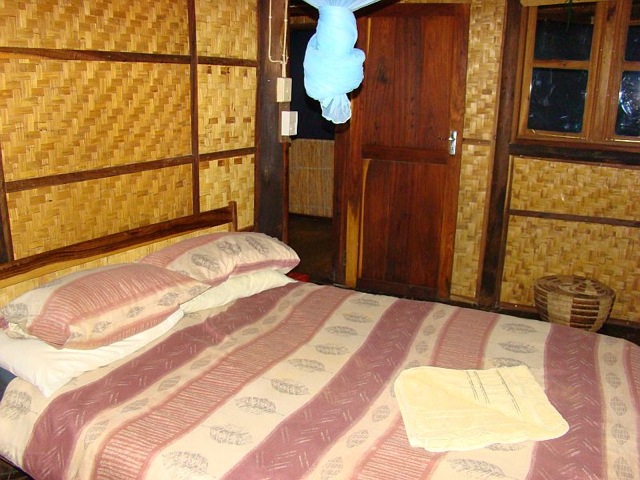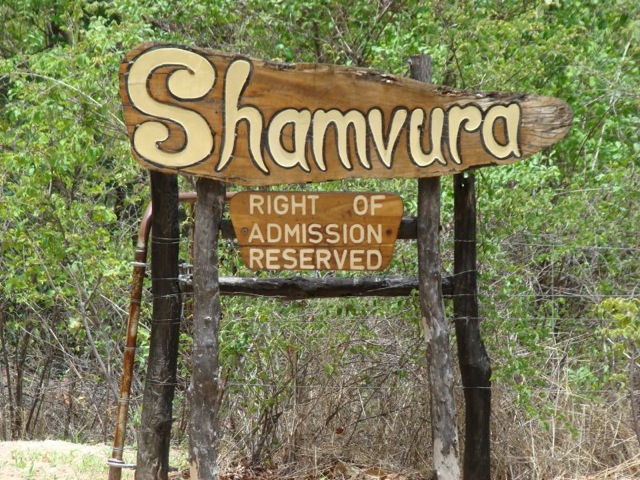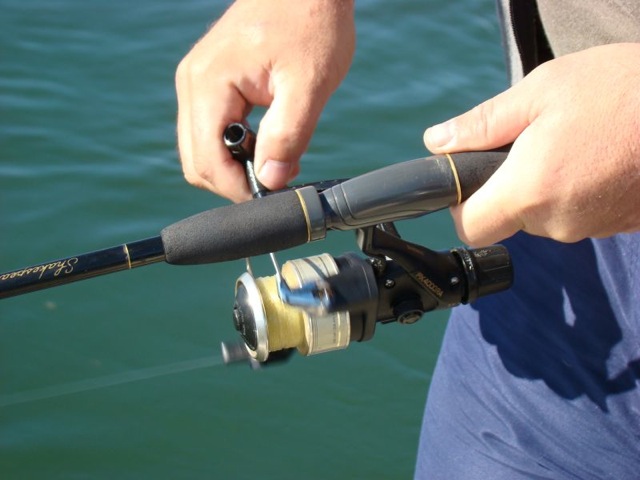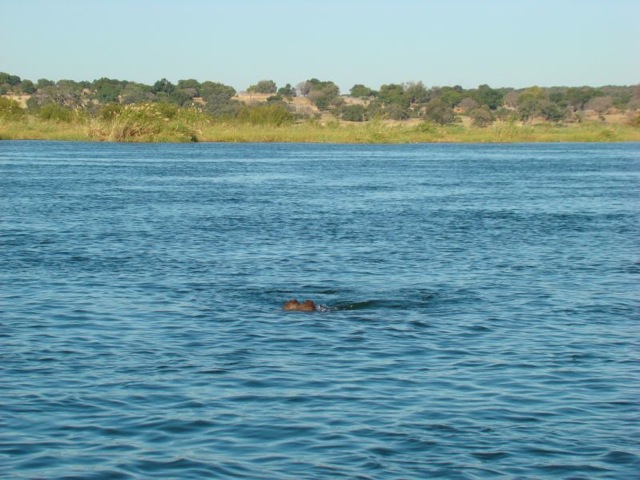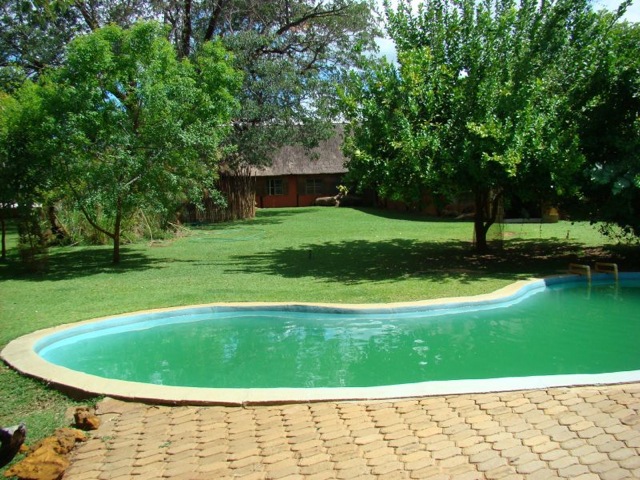Shamvura Camp is the only tourism accommodation facility within a 50km radius, providing access to visitors to more than 15km of a pristine river system with a vast adjoining floodplain created by the confluence of Cuito and Okavango Riviers.
Situated high on a prominent sand dune, fronted by the meandering Okavango River, this location affords the visitor some spectacular vistas of up to 30km over the river into the Angolan floodplains. They also have the added advantage of being surrounded by both climax riverine forest, woodland and extensive floodplains creating a haven for a large diversity of fish, birds and other wildlife.
During the rainy months (December-April) when the river rises, the surrounding wetland becomes a vast expanse of water and reed vegetation. These area are vital breeding grounds to almost 90 species of fish. This becomes a food haven for over 60 species of wetland birds and several rare reptile and amphibian species.
The property has one of the last remnants of a natural riverine forest compromising mainly of Knobthorn Acacia (Acasia nigrescens), Baobab (Andansonia digitata) and Wild Fig (Ficus spp).
Accommodation:
The cottage in the forest gives the visitor a birds-eye view of this unique habitat. The accommodation remains modest and private. It is most suited to small self-catering parties who are interested in quality experiences. They emphasize the importance of personalized attention.
All accommodation facilities are serviced daily. Linen and firewood are provided. In addition each unit has a separate all-weather entrance road, spacious turning and parking area with exclusive privacy and safety.
Tree Top Cottage:
Elevated on a raised wooden platform, constructed from wood and thatched, it is situated in the forest giving a splendid view from its spacious veranda. It has one large main bedroom with a double and single bed, a ceiling fan and en-suite bathroom. The open-plan dining/kitchen/living area provides space for up two additional beds, with a bedside lamp and shelf which although not private is quite cosy. The kitchen is fully equipped with crockery and cutlery for six people and includes a fridge/freezer and stove. There is also a private enclosed and grassed braai (barbeque) area. The cottage is supplied with electricity.
Maroela Tent (2 bed unit):
A cabin tent on a raised wooden platform with en-suite shower/toilet facilities and a large spacious covered veranda and an excellent view of the river from behind the forest fringe. It is situated next to a large Maroela tree (hence the name) and has a large enclosed grassed braai (barbeque) and washing area. There is a large parking and turning area, partially enclosed. There is no electricity but battery lamps are provided.
Combretum Tent (3-4 bed unit):
A cabin tent on a raised cement base with a covered veranda. The shower/toilet facility is not en-suite but close by and there is a braai (barbeque) and washing area. This tent is situated under a large Combretum colonum tree with dense shade. The whole unit with large parking areas is enclosed with a reed and pole fence, offering a good view of the Angolan floodplains. There is no electricity but battery lamps are provided.
Manketti Tent (3–4 bed unit):
A cabin tent on a raised wooden platform with a veranda offering a good view of the Angolan floodplains. Shower facilities en suite. It has its own grassed and enclosed braai (barbeque) and washing area with a partially enclosed large parking and turning area for vehicles. There is no electricity but battery lamps are provided.
Ushivi Tent (3-4 bed unit):
A cabin tent on a cement base, near the main complex with a large, shady, very spacious reed-fence enclosed area giving absolute privacy, but unfortunately no view. A braai (barbeque) area with outside lighting and a fully equipped kitchen, with crockery and cutlery for up to eight people, a fridge/freezer and stove. It has double ablution facilities within the enclosed area, electricity, lights and a plug point.
This unit has an adjoining Guide’s Nook with a shaded raised block for a tent and an electrical plug point.
Camping:
At Strychnos Campsite, there are six spacious and privatised sites each enclosed with a reeded fence and served by a centralised double ablution block on a raised wooden platform with washing facilities and a roofed area with electrical plug points and lighting. Each site has a built-up fireplace with wood, adjustable braai-grid, a water tap and also a raised platform for tents. Exclusive camping is available at either Ushivi or Combretum tents, (when unoccupied), which have outside ablution facilities.
Activities:
Birding:
Their location, being on a unique highpoint overlooking some extensive floodplains on the Okavango River system, affords some excellent birding opportunities. The current list being 412 species, of which 21 are endemic/near-endemic, with 85 ‘Hotties’ or sought-after species. Grey-headed and Meyer’s Parrots are regular sightings overhead flying to favoured feeding trees. The property includes some of the only climax Knobthorn forest remaining on this heavily de-forested river system. This provides excellent lookout or hunting habitat for raptors like Wood Owl, Barred Owlet, White-faced Scops-owl, Western Banded Snake Eagle, African Goshawk, Black Sparrow Hawk, Long-crested Eagle, Ayre’s Hawk-eagle, Cuckoo Hawk Peregrine Falcon, African Hobby and Bat Hawk, amongst others which are therefore attracted to this spot, some in fact breeding here.
They encourage their guests to walk around the extensive property where the avid birder may run into numerous feeding parties of forest-dwelling birds like White-browed Robin Chat, Swamp Boubou, Black-crowned Tchagra, Black-collared Barbet, Bulbuls, Greenbuls, Brownbuls and various Flycatchers, Woodpeckers and Wood hoopoes. Shelley’s Sunbird is also often seen here.
The surrounding open scrubland/grassland areas offer sightings of the many smaller seedeaters like Brown Firefinch, Orange-breasted Waxbill, and seasonal Warblers, Cisticolas, Larks and Pipits. When seasonal rainwater pans here fill up, they provide good habitat for Rosy-throated Longclaw, Yellow Wagtail, Dwarf Bittern, Snipes, Cuckoo-finch and other nondescript waders
There is a registered bird-ranging station and qualified staff available to bird-watchers. Specialized guided walks can be arranged;
Hiking:
Although they are situated within a rural area the local population is relatively sparse in this area. They are also surrounded by hundreds of hectares of uninhabited floodplains which, during drier months, afford some excellent walking opportunities. Although, as with most rural communities throughout Africa, there are no large game species anymore in the area, there are some interesting plains bird species to be seen only on these drier floodplains as well as smaller mammals, insects and reptiles that have escaped the attention of the local people. Being on the border with Angola, where almost no knowledge of smaller animal life is available, is a distinct advantage, and we often find animal, insect and reptile species which are unknown from elsewhere in Namibia. They encourage guests to walk freely inside the property, as it is quite safe, or when necessary a guide can be arranged.
Guided walks in the neighbouring woodlands offer a host of exciting rarities like Souza’s Shrike (a breeding resident), Racket-tailed Roller, Sharp-tailed Starling, Green-backed and Brown-backed Honeybirds, White-breasted Cuckooshrike, African and Eurasian Orioles, Long-legged Buzzard, Rufous-bellied Tit, Green-capped Eremomela, Tree and Wood Pipits, Arnott’s Chat, Red-faced Crombec, Orange-winged Pytilia, Retz’s Helmet-shrike, Thick-billed Cuckoo, Black-faced Babbler and Bradfield’s Hornbill;
Boat trips:
Boat trips on the river reveal Long-toed Lapwing, Great Snipe, African and Painted Snipe, Kingfishers, Bee-eaters, Coppery-tailed Coucal, Rails, Crakes, Allen’s Gallinule, Lesser Moorhen, Lesser Jacana, Little Bittern various Ducks and Geese, Open-billed Stork, White-backed Night-heron, Rufous-bellied heron, Slaty Egret, other Herons and Egrets, Rock Pratincole, Fish-eagle, Harriers, Luapula’s and Chirping Cisticolas, Greater Swamp Warbler and many other Waders and Waterbirds.
The extensive floodplains, before and during the rainy season, offer excellent breeding and feeding opportunities for these wetland birds and the many sandbank islands for African Skimmer, Water Thick-knee and Wattled Plover, among others.
Bird-ringing:
They are a recognised ringing station with qualified and registered ringers, and permanently placed mist-nets in strategic places on the property. For those guests specifically interested, they offer two choices of a daily ringing programme to allow the enthusiastic visitor direct involvement with the hands-on capture and ringing procedures. These arrangements require some prior notification. All records will be accurately catalogued and directed to AFRING at University of Cape Town.
A Novice Ringing Exercise would include a full day long and would involve the procedure of opening the permanently placed mist nets in different habitats within the property, with instructions on why they are placed there and how they function. Then the measuring and recording procedures will be demonstrated and discussed at length. The nets are then regularly monitored for captured birds, which will demand walking from net to net, to minimise the time a captured bird spends in the nets. Once a bird is captured, the guest will have direct involvement with the actual freeing and handling process under instructions, after which the bird will be processed, ringed and released. This activity will be repeated throughout the day while the nets are up and active. Guests are warned that there will be periods of inactivity during the day, mostly midday, when bird movement is minimised because of the hot temperatures. Periods of intense activity are normally early morning and late afternoon.
An Adventurous or Experienced Ringer Exercise only differs from the above, in that nets are freshly placed in completely new areas, possibly involving vehicle or boat travel, and the daily activity is sometimes far from the Camp, when and if, conditions allow. Guests are encouraged to prepare themselves for a full day away, and be self-sufficient.
Fishing:
This stretch of the Okavango River still offers some excellent opportunities for big Tiger fish, Barbel (Catfish) and the predatory Bream species like Nembwe, Thin-face and Hump-back Largemouth and ‘Three-spot’ which can be caught using light spinning rods and a variety of lures, spinners, live-bait or drift-bait.
The more sedate fishing with worms and bait afford some good opportunities for Red-breasted and Green-headed Bream. They encourage fly-fishing, but the fast flowing river usually frustrates the less persevering and fanatical fly-fisherman. This technique is therefore usually more successful during the lower water level months, from June to November when the current is also slower. The more active Bream fishing months are the colder periods, particularly May, June and July, and when the water is lower, until September. Tiger fishing is available throughout the year, but the more active times are during the high water months of January to April.
Some really active fishing is available for varying periods as the river level falls and the breeding fish and young are coming our of the floodplains into the mainstream. Alternatively, when the river level is rising and flowing into the adjoining floodplains allowing the breeding fish access into these areas to breed. These highly active times vary from year to year depending on rainfall, locally and in the Angolan catchment area.
‘Wato‘ (Makoro) trips:
Shamvura Camp also offers guests the peaceful option of being ‘poled‘ through the floodplains on a traditional ‘wato’/’makoro‘. The best months being from January to May when the river level is high and the floodplains provide a variety of channels and pools with a variety of interesting plant, fish and birdlife, ideal for quiet canoeing trips. They arrange ‘wato’ (dug-out canoe) trips with a local guide, giving you more access into the flooded wetlands unavailable to motorboats;
Game Park visits:
Two distinctly different Game Parks are within easy reach from our location. These are Mahango Game Park (on the river) and Kaudom Game Reserve (in the interior “Sandveld” area).
Mahango Game Park is an hour’s drive from us on tarred roads for most of the way. Although the riverine routes in the Park are suitable for normal 2×4 vehicles, the majority of the Park is not. Most of the game and birds are however, within reach of the riverine areas and therefore, accessible to 2×4 vehicles. Being a small reserve with good species diversity the visitor can usually have a satisfying day’s excursion. Guided tours can be arranged, and more information on the Park can be made available on request.
Khaudum Game Reserve is actually closer, but the arduous 4×4 access road makes reaching the Park an experience not for the faint-hearted. The park has two basic overnight camps, and a trip to this remote, yet worthwhile Park, requires some prior planning and preparation before an extended excursion should be attempted. Being a large, extensive Park with many unmarked routes between water points it is advisable to consider a guide. The authorities also insist that each party is required to have no less than two vehicles for safety reasons. We can make the necessary arrangements and provide a guide and vehicle if necessary;
Swimming pool and recreational deck:
A large, private swimming pool and comfortable tree-top viewing deck is available to resident guests;
Private bar and lounge:
Guests may relax in the main entertainment area with a privatized bar with DSTV in the main lounge;
Crafts and basketry:
This is the perfect opportunity to meet crafters on site or on a craft excursion. View and buy a wide selection of handcrafts and basketry;
Micro light flights:
Stunning scenery of the Angolan floodplains and meandering river system can be viewed from the air;
Traditional dance and music sessions:
Local cultural dancing group from the Gciriku are performs for the resident guests.
General information:
- Except for camping all units have linen, towels, soap, drinking water, mosquito nets and repellent;
- All units including camping units are serviced daily;
- All guests have access to the large filtered swimming pool with a tree top deck overlooking the
- Okavango River and Angolan floodplains. The deck offers good birding with bird feeder and birdbath;
- The deck is a wonderful sundowner spot;
- We have a private bar and lounge with DSTV available for guests;
- All units are connected by all weather roads and clearly signposted; and
- All units have firewood provided.

